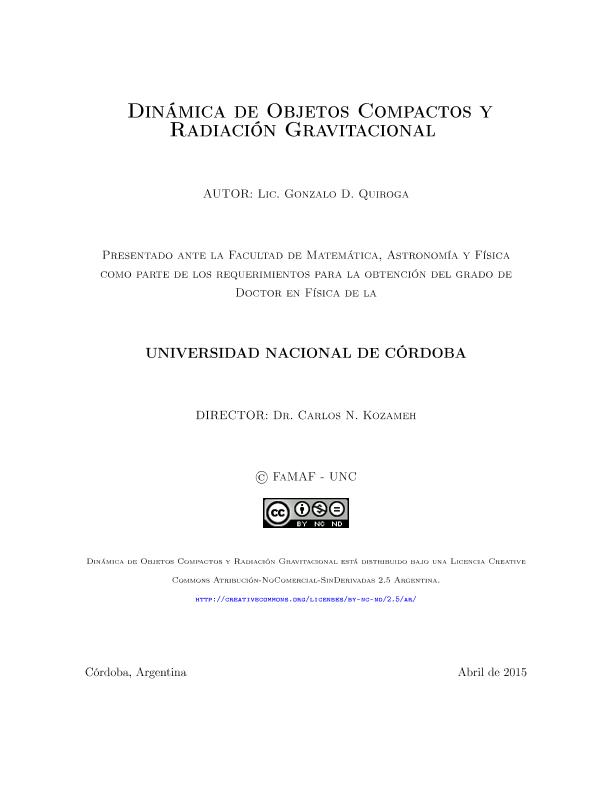Mostrar el registro sencillo del ítem
dc.contributor
Kozameh, Carlos Nicolas

dc.contributor.author
Quiroga, Gonzalo Damián

dc.date.available
2019-07-16T17:04:35Z
dc.date.issued
2015-03-26
dc.identifier.citation
Quiroga, Gonzalo Damián; Kozameh, Carlos Nicolas; Dinámica de objetos compactos y radiación gravitacional; 26-3-2015
dc.identifier.uri
http://hdl.handle.net/11336/79629
dc.description.abstract
En esta Tesis haciendo uso de la estructura asintótica del espaciotiempo y del formalismo de Newman-Penrose definimos la noción de centro de masa y spin para sistemas gravitacional es que emiten radiación gravitacional y electromagnética. A diferencia de otras formulaciones disponibles en la literatura, una de las características centrales de nuestro formalismo es el uso de cortes reales de Newman-Unti que son generados por líneas mundo del espaciotiempo. A partir de estos cortes se obtienen las ecuaciones para el momento angular y el momento dipolar másico,estas ecuaciones son similares con su contraparte newtoniana a pesar de que en nuestra formulación estas cantidades han sido definidas utilizando variables en la frontera nula de un espaciotiempo asintóticamente plano. las ecuaciones que vincula la evolución temporal del momento dipolarmásico y el momento angular con la radiación gravitacional emitida y encontramos la ecuación de movimiento para el centro de masa del sistema.
dc.description.abstract
In this thesis we define the notion of center of mass and spin for gravitationalsystems that emits gravitational and electromagnetic radiation, to do this we use theasymptotic structure of the spacetime and the Newman-Penrose formalism. Unlike otherapproaches, a central feature in our formulation is the use of real Newman-Unti cuts atnull infinity that are generated by worldlines of the spacetime. From these cuts we obtainthe equation for the angular momentum and mass dipole, these equations are similarto their Newtonian counterparts although in our formulation these amounts have beendefined using only variables at the null boundary of an asymptotically flat spacetime.Finally we derive equations linking their time evolution to the emitted gravitationalradiation and also we get the equation of motion for the center of mass of the system.
dc.format
application/pdf
dc.language.iso
spa
dc.rights
info:eu-repo/semantics/openAccess
dc.rights.uri
https://creativecommons.org/licenses/by-nc-sa/2.5/ar/
dc.subject
Espaciotiempos Asintoticamente Planos
dc.subject
Relatividad General
dc.subject
Radiacion Gravitacional
dc.subject.classification
Astronomía

dc.subject.classification
Ciencias Físicas

dc.subject.classification
CIENCIAS NATURALES Y EXACTAS

dc.title
Dinámica de objetos compactos y radiación gravitacional
dc.type
info:eu-repo/semantics/doctoralThesis
dc.type
info:eu-repo/semantics/publishedVersion
dc.type
info:ar-repo/semantics/tesis doctoral
dc.date.updated
2019-07-16T13:36:45Z
dc.description.fil
Fil: Quiroga, Gonzalo Damián. Consejo Nacional de Investigaciones Científicas y Técnicas. Centro Científico Tecnológico Conicet - Córdoba. Instituto de Física Enrique Gaviola. Universidad Nacional de Córdoba. Instituto de Física Enrique Gaviola; Argentina
dc.relation.alternativeid
info:eu-repo/semantics/altIdentifier/url/https://rdu.unc.edu.ar/handle/11086/2790
dc.conicet.grado
Universitario de posgrado/doctorado

dc.conicet.titulo
Doctor en Física
dc.conicet.rol
Autor

dc.conicet.rol
Director

dc.conicet.otorgante
Universidad Nacional de Córdoba. Facultad de Matemática, Astronomía y Física

Archivos asociados
